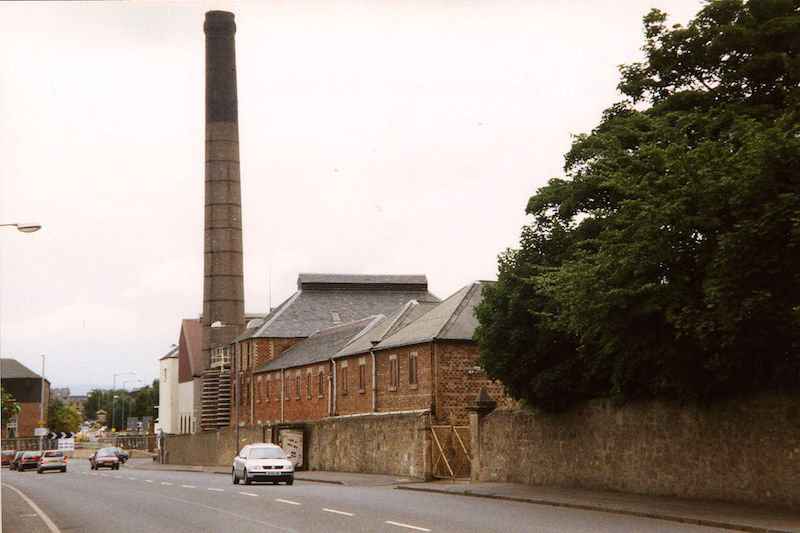The Rise and Fall of Rosebank Distillery
Rosebank is as mystical as a unicorn for some of us, perhaps a holy grail of sorts. It nestled along the banks of Forth and Clyde canal between Edinburgh and Glasgow, in the town of Camelon. As a closed distillery, its reputation grew as whisky lovers recognised the excellent liquid that the distillery once produced. There was, therefore, a lot of rejoicing, when Ian McLeod Distillers announced the intention of reopening Rosebank Distillery in October 2017. The esteemed company purchased the site from the Scottish Canals and the trademarks from Diageo with the full intention of rebuilding this once majestic Lowland distillery.
The Humble Beginnings of Rosebank Distillery
Historical records pointed to a distillery in Falkirk that existed as far back as 1798. Founded by the Stark brothers, this first distillery was the forefather to the currently mothballed Rosebank distillery. In 1817, a man named James Robertson opened another distillery nearby and called it Rosebank. The exact location was unclear, but it could be the same site as the current one. Unfortunately, the early Rosebank distillery closed permanently in 1819.
In 1827, John Stark (one of the Stark brothers) opened a distillery on the west bank of the Forth and Clyde canal and named it Camelon Distillery (after the town). He took charge of the distillery until his death in 1836. The distillery then passed to Thomas Gunn and his father. After four years, in 1840, a man named James Rankine approached the Gunns to lease or purchase the Camelon distillery malting grounds (on the east side of the canal). The deal went through, and Rankine set up a new distillery under the Rosebank name.
The Rise of Rosebank
The new Rosebank proliferated and expanded in 1845. Rankine also brought out the Gunns when Camelon distillery went bankrupt in 1861. He demolished the old distillery and left only the malting floors on the west side of the canal. By 1864, Rankine rebuilt the distillery, creating Rosebank as a distillery set across two sites on each side of the Forth and Clyde canal with a swing bridge to link them.
In 1886, Alfred Barnard visited the distillery, describing it as a distillery “set across two sites”. The former Camelon distillery’s malting floors on the west side of the canal produced the malt before transferring it to the distillery on the east side with the help of the swing bridge. Barnard also noted that Rosebank distillery had storage of 500,000 gallons of whisky in their warehouse.
By 1894, the Rosebank Distillery Ltd came into existence as further evidence of its success. It was also one of the many companies that amalgamated to form the Scottish Malt Distillers. The group later became part of DCL.
The Steady Fall of Rosebank
Rosebank was a premier Lowland whisky, but United Distillers decided to mothball the distillery in 1993. The company said that the distillery was no longer commercially viable as it needed a £2m upgrade to comply with the European standards of the time. Hence, the distillery closed with many historical features of whisky production within.
United Distillers sold off the warehouses on the west banks of the canals, and the new owners redeveloped it by 1988. In 2002, Diageo sold the distillery buildings and contents to British Waterways while the malting floors become a housing development. 2008 saw some hope for Rosebank’s revival as the new owners made plans to reopen Rosebank in Falkirk with its original equipment. Unfortunately, during the Christmas and New Year period of 2008/2009, metal thieves stole the original Rosebank stills, together with all the other material. Efforts of recovery were in vain.
The Planned Revival of Rosebank
The plans of revival continued despite the stolen equipment, culminating in the approval of the Scottish Government. News of setting the new building near the early distillery of 1798, near Laurieston, abound. Rumours float around with the hopes of the new distillery releasing its whisky under the Rosebank name, but Diageo, who owns the trademark denied it. In the meanwhile, it continued to release limited bottles of the original Rosebank whisky.
Finally, in October 2017, Lan MacLeod Distillers bought the Rosebank trademark from Diageo, purchase the land from the Scottish Canals and confirms the re-building of the Rosebank Distillery. The new distillery will produce the whisky in its old style, with equipment modelling after its original stills.
The Rosebank Whisky
Flora and Choc do not profess to drink many of the Rosebank whisky, but we have tried a few. Geek Choc loves Rosebank, and he believes that the new distillery will do well if it models the old style. Geek Flora agrees that Rosebank is a premium malt on its own, but she doesn’t like it as much as she loves Littlemill.
We did a couple of reviews of Rosebank earlier this week. The first one is an official bottling by Diageo – a 21-year-old whisky under the Roses series. The second is an independent bottling by Blackadder – a 14 years old cask strength Rosebank. Both have their merits, with Geek Flora liking the official bottling better and Geek Choc liking the independent bottling more.
The Future of Rosebank
We hope that the new Rosebank will be as successful as the old. With Ian MacLeod Distillers, we expect the distillery to flourish and grow under their able hands.



